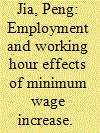| Srl | Item |
| 1 |
ID:
130981


|
|
|
|
|
| Publication |
2014.
|
| Summary/Abstract |
Using a difference-in-differences model, the present paper provides empirical evidence of minimum wage effects on employment and working hours in China. The results show that male employment is not affected by a minimum wage increase, although men's working hours do increase. In contrast, female employment is more likely to be negatively affected by a minimum wage increase, while their working hours remain unchanged. This may lead to women being in a more disadvantaged position in the workforce, and adopting a monthly minimum wage may induce firms to extend men's working hours. Therefore, to better protect disadvantaged workers, we suggest that minimum wage regulation should focus on the target group of less-educated women, and that a unified minimum hourly wage needs to be set for both full-time and part-time workers. Meanwhile, the importance of human capital accumulation should be addressed in alleviating the negative effects of minimum wage increases.
|
|
|
|
|
|
|
|
|
|
|
|
|
|
|
|
| 2 |
ID:
161827


|
|
|
|
|
| Summary/Abstract |
Using the data from an original survey on rural migrant workers from Suzhou industrial sector in 2013, we estimate the wage effect of both union membership and union coverage across the wage distributions using decomposition approach based on unconditional quantile regression. The results show that union membership has a significant effect on the wage level of rural migrant workers across the wage distribution. The effect of coefficient differences which results from the different rewarding systems explains the majority wage differentials between union members and non-members in non-unionized firms. There is also significant union coverage effect at the lower part of the distribution when comparing the union-covered non-member to the nonunion-covered non-member, which is also mainly caused by the coefficient effect. By contrast, wage differentials between union members and non-members in unionized firms are attributed to significant composition effect, which reveals that union members are positively selected within unionized firms. As a result, the positive wage effect of union is limited to the more advantaged group among migrant workers.
|
|
|
|
|
|
|
|
|
|
|
|
|
|
|
|